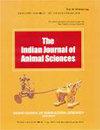基于微卫星标记的有角、轮询的巴厘牛与班腾牛的比较
IF 0.3
4区 农林科学
Q4 AGRICULTURE, DAIRY & ANIMAL SCIENCE
引用次数: 0
摘要
巴厘岛牛(Bos javanicus)是来自班腾的驯养牛。巴厘牛有一个独特的特点,那就是白色的短袜。在南苏拉威西省Enrekang区的Maiwa育种中心,被调查的巴厘岛牛被大量饲养,包括雄性和雌性。微卫星广泛应用于群体遗传学和数量性状位点的研究。因此,本研究旨在观察遗传多样性,并确定微卫星能否区分有角巴厘牛、有轮巴厘牛和班腾牛作为它们的野生亲缘种。从两个不同种群的57头巴厘岛牛的血液样本中分离出DNA:来自巴厘岛省努沙Penida岛的有角巴厘岛牛(n=20),来自南苏拉威西省Maiwa育种中心的有轮巴厘岛牛(n=37),以及来自雅加达省拉古南动物园(n=10)和东爪哇省泗水动物园(n=10)的20头班腾牛样本。利用11个微卫星标记进行基因分型。使用GeneMapper 5.0版本确定每个微卫星标记的大小。采用CERVUS 3.0.7版程序进行观察杂合度值(Ho)、期望杂合度值(He)、品种内杂合度亏缺(Fis)、基因流量(Nm)、Hardy-Weinberg平衡(HW)和等位基因频率分析。执行FSTAT 2.9.4以获得两个不同种群的Fis值。同样,使用STRUCTURE 2.2版本分析贝叶斯聚类分配。11个微卫星标记的多态性信息含量在0.390 ~ 0.879之间。此外,我们发现所有标记的Fis值都表明在有角和有轮的巴厘岛牛种群中不存在近亲繁殖。我们还发现,被调查的巴厘牛比有角的巴厘牛有更多的私人等位基因。利用贝叶斯分析方法,我们发现轮作巴厘牛和有角巴厘牛的遗传结构存在差异,K值在K=3时最优。结果表明,ILST6等位基因288、TGLA53等位基因132和TGLA227等位基因70可作为巴利牛和班腾牛之间的私有等位基因。本文章由计算机程序翻译,如有差异,请以英文原文为准。
Comparison of horned, polled Bali cattle and Banteng based on microsatellite markers
Bali cattle (Bos javanicus) are domesticated cattle from Banteng. Bali cattle have unique characteristics that is the white sock. In the Maiwa breeding center, Enrekang district, South Sulawesi Province, polled Bali cattle are being kept in large quantities, both male and female. The microsatellites are widely used in the study of population genetics and quantitative trait locus. Therefore, the study aims to observe genetic diversity and determine whether microsatellites can distinguish horned Bali cattle, polled Bali cattle, and Banteng as their wild relatives. DNA was isolated from blood samples of 57 Bali cattle from two different populations: horned Bali (n=20) from Nusa Penida Island Bali province, polled Bali cattle (n=37) from Maiwa Breeding Center, South Sulawesi province, and 20 samples of Banteng from Ragunan Zoo (n=10), Jakarta Province and Surabaya Zoo (n=10), East Java Province. Genotyping was done using 11 microsatellite markers. The size of each microsatellite marker was determined using GeneMapper version 5.0. The observed heterozygosity value (Ho), expected heterozygosity value (He), the heterozygote deficit within the breed (Fis), gene flow (Nm), Hardy-Weinberg equilibrium (HW), and allele frequency were performed using CERVUS version 3.0.7 program. The FSTAT 2.9.4 was performed to obtain Fis value from two different populations.Similarly, bayesian clustering assignments were analyzed using STRUCTURE version 2.2. The polymorphism information content of eleven microsatellite markers ranged from 0.390-0.879. Moreover, we found Fis values of all markers which depicted that there is no inbreeding in horned and polled Bali cattle populations. We also found that polled Bali cattle have more private alleles than horned Bali cattle. Using Bayesian analysis, we found different genetic structures between polled Bali and horned Bali cattle with the K optimal at K=3. Findings indicated that ILST6 allele 288, TGLA53 allele 132, and TGLA227 allele 70 can be considered as the private allele to differentiate between the horned, polled Bali cattle and Banteng.
求助全文
通过发布文献求助,成功后即可免费获取论文全文。
去求助
来源期刊

Indian Journal of Animal Sciences
农林科学-奶制品与动物科学
CiteScore
0.60
自引率
25.00%
发文量
220
审稿时长
8 months
期刊介绍:
Articles published in The Indian Journal of Animal Sciences encompass a broad range of research topics in animal health and production related to cattle, buffalo, sheep, goat, camel, equines, pig, rabbit, yak, mithun, poultry and fisheries. Studies involving wildlife species and laboratory animal species that address fundamental questions about their biology will also be considered for publication. All manuscripts must present some new development and must be original, timely, significant and scientifically excellent. Papers will be rejected if standards of care of, or procedures performed on animals are not up to those expected of humane veterinary scientists. At a minimum, standards must meet the International Guiding Principles for Biomedical Research involving Animals, as issued by the Council for International Organizations of Medical Sciences. (C.I.O.M.S., c/o WHO, CH 1211 Geneva 27, Switzerland). Articles reporting new animal disease must follow GOI directive as given in detail in Guidelines to Authors.
 求助内容:
求助内容: 应助结果提醒方式:
应助结果提醒方式:


